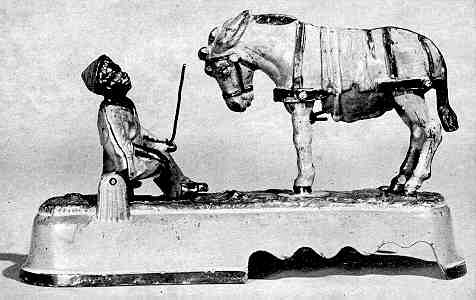I Always Did ’Spise A Mule – Part II
by F.H. Griffith - HOBBIES Magazine - May, 1975

As we reach No. 247 in the numerical classification, the versatile designer of mechanical banks, James H. Bowen, once again comes into the picture with another of his mechanicals, the I Always Did ’Spise A Mule. Does the name sound familiar — it should, who else but Bowen would use the same name for two banks that are somewhat similar, but quite different. For identification purposes, we use the word Jockey in parenthesis along with the name to identify the other ’Spise A Mule, since there is a figure astride the mule. The one with the jockey is the first to utilize the name and was protected by a patent issued April 22, 1879 covering a toy. Both a toy and a mechanical bank were made under the patent.
The I Always Did ’Spise A Mule pictured had a patent all its own as a toy money box, and it was issued to Bowen, April 27, 1897. It is a well detailed patent with five drawings accompanying the text. As with the early version of 1879, this later namesake was also made by the J. & E. Stevens Company of Cromwell, Conn. It is apparent that the first version was a good seller for a number of years, and Stevens obviously took kindly to the changed and later model of 1897 as some 18 years had elapsed since its initial introduction. The one of 1897 now under discussion must have also sold well over the years as it was still being manufactured by Stevens in the 1920’s. All evidence indicates the bank enjoyed wide popularity in its day.
The drawing for the 1879 patent for the toy shows a dog in sitting position by the rear legs of the mule. When the mule kicked, throwing the rider forward, the rear legs kicked the dog over backward. Neither the toy nor the bank were made in this fashion — that is to say, the dog was omitted. The writer feels, however, that this was the beginning of the idea for the later 1897 ’Spise A Mule with the figure of the boy being kicked over backwards. It makes sense that Bowen utilized this part of his original idea of a figure being kicked over as on his 1897 version now under discussion. And, by the way, the 1897 patent drawings conform to the bank as manufactured.
The bank shown is a fine all original condition example with paint in excellent condition. Colors are as follows: The base sides are red with striping in yellow and black at the bottom and a yellow stripe at the top edge. The top surface is light green with touches of red and yellow, and the raised letters of the name in white. The mule is tan with red and yellow blanket, and black mane, hooves, tail, and harness straps. Decorations in red and yellow are on the straps. The boy has red trousers and hat and a yellow shirt. His face, hands, and shoes are black. He has white eyes, black pupils, and a red mouth. He holds a black stick in his left hand. As with the other ’Spise A Mule (Jockey), colors will vary on this version as well. As example, in later years the mule was painted white and the base sides were also done in yellow. In the case of this bank the painting variations are helpful in establishing the rough time period of any given example. All those with a white mule were in the most recent time period of manufacture, in the 1920’s.
To operate the bank, a coin is placed in the provided section underneath the seated boy. When the lever, just in front of mule’s rear legs, is pressed he kicks up and out and turns counter clockwise facing the opposite direction. In so doing, the mechanism causes the boy to fall over backward as though kicked by the mule. The coin slides into the provided slot in the base. Very fast, excellent and quite realistic. The bank must be reset for operation. The mule is manually turned around and set into position as shown in the picture and the boy is reset as shown.
The I Always Did ’Spise A Mule is one of the fine action banks having a companion bank and toy all bearing the same name. Stevens sold the bank under the name Kicking Mule, and in 1928 the price was $16.75 a dozen.
